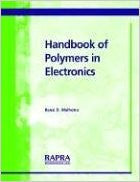Handbook of Polymers in Electronics
With the continuing drive for higher circuit density and very high-speed data processing, the search for new polymeric materials to use in microelectronics has intensified. The development of polymers for electronics applications is an open field wherein polymers may be used as insulating materials or tailored for desired electronic properties for specific applications. Conjugated polymers have been projected to have numerous applications and are presently at centre-stage of R&D.
The Handbook of Polymers in Electronics has been designed to discuss the novel ways in which polymers can be used in the rapidly growing electronics industry. It provides a discussion of the preparation and characterisation of suitable polymeric materials and their current and potential applications coupled with the fundamentals of electrical, optical and photophysical properties. It will thus serve the needs of those already active in the electronics field as well as new entrants to the industry.
The Handbook of Polymers in Electronics has been designed to discuss the novel ways in which polymers can be used in the rapidly growing electronics industry. It provides a discussion of the preparation and characterisation of suitable polymeric materials and their current and potential applications coupled with the fundamentals of electrical, optical and photophysical properties. It will thus serve the needs of those already active in the electronics field as well as new entrants to the industry.
1. Charge Transport in Conjugated Polymers
2. Electrical Properties of Doped Conjugated Polymers
3. Non Linear Optical Properties of Polymers for Electronics
4. Luminescence Studies of Polymers
5. Polymers for Light Emitting Diodes
6. Photopolymers and Photoresists for Electronics
7. Polymer Batteries for Electronics
8. Polymer Microactuators
9. Membranes for Electronics
10. Conducting Polymer-Based Biosensors
11. Nanoparticle-Dispersed Semiconducting Polymers for Electronics
12. Polymers for Electronics
13. Conducting Polymers in Molecular Electronics
2. Electrical Properties of Doped Conjugated Polymers
3. Non Linear Optical Properties of Polymers for Electronics
4. Luminescence Studies of Polymers
5. Polymers for Light Emitting Diodes
6. Photopolymers and Photoresists for Electronics
7. Polymer Batteries for Electronics
8. Polymer Microactuators
9. Membranes for Electronics
10. Conducting Polymer-Based Biosensors
11. Nanoparticle-Dispersed Semiconducting Polymers for Electronics
12. Polymers for Electronics
13. Conducting Polymers in Molecular Electronics
Bansi Dhar Malhotra is Scientist-in-Charge at the Biomolecular Electronics & Conducting Research Group, National Physical Laboratory, New Delhi, India. He is presently engaged in an R&D programme on conducting polymers, biosensors, Langmuir Blodgett films and molecular electronics. He is the author of more than 50 research papers and has been invited to speak at many international conferences.




